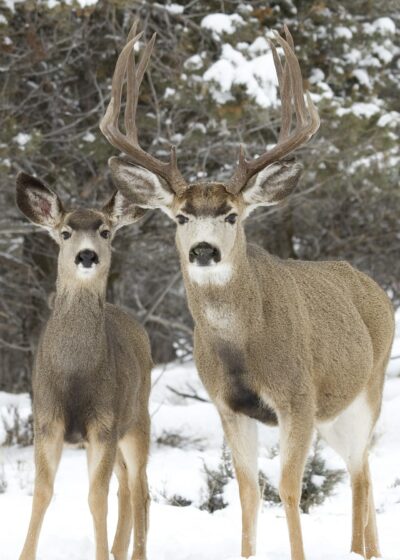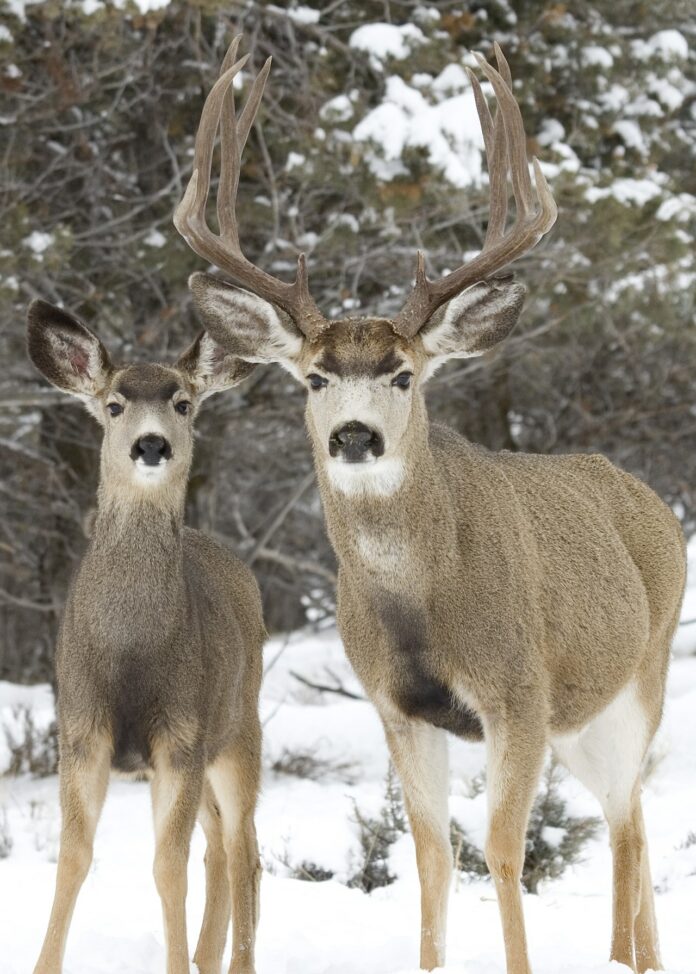BY HARRY WEEKES

I love full moons. More specifically, I love how a full moon transforms the night. Or, for me, the very early morning. What is often a cloak of real darkness becomes a wonderful world of black and white. More accurately, it is a world of contrast, cast mostly in various shades of dark blue and purple. When you cover this world in snow, something else happens altogether and you realize there is at least a third way to describe qualities of seeing. There is light. There is dark. And there is full moon over snow. This is where the world becomes discernible in a distinct way, and there is a quality of seeing akin to what plasma is to matter—something in between, something different.
I think the other animals feel this, too.
At the end of November, before the full moon, I stood staring out one of my windows at a mule deer that was fewer than 10 feet from me. She picked up her head and looked directly at me. She flitted her ears forward and trained them on my shadow, slowly moving one, then the other, in a smooth arc that curved from facing me to listening over her right shoulder, then her left.
I knew she was a female because I could see the distinct pattern of her irises and I could count the number of whiskers on her muzzle (female deer have more than males).
Just kidding. I knew it was a doe because her two babies—this year’s twins—were with her, and took turns looking at me and twitching their ears, only to quickly lose interest and move to browsing in the sage.
For her part, mama kept referring to me as she slowly guided the kids away—a measured walk, quite distinct from the bolting and bouncing when they see me in the day, or the startling crash when I flush them in the dark.
Then, in early December, on the other side of the full moon, in that wonderful phase called the waning gibbous, I came across a great horned owl, an inky silhouette cut into the sky, perched above the Draper Preserve. I wrapped around to the front of the bird, its barring, and a small but distinctive white blaze apparent on its chest.
We stared at each other as I walked a half circle around the bird—its body stock still, its head moving smoothly from looking over its back, to over its shoulder, to directly at me. I moved on. And when I moved back, the owl was gone—having left, and taken off on its silent way.
In this light, at this time, something different happens, something that feels like shadows coming together. I see mine, a plump, down-covered silhouette, plodding along the creek, and the river, and into the field. I know that I am bright orange in the light of my house or in the light of day.
But in these mornings, we all seem to be something different, neither quite our normal selves, nor quite something else. A shared inquisitiveness collapses normal distances, or at least makes proximity more tolerable. I wonder if I could just walk up and touch the deer. Or if I could reach out and touch the owl. I try neither, but just stand and stare. The same way I stare at the moon, moving through its cycles, not just reflecting sunlight but somehow transforming it; less a mirror than a window into something.
Harry Weekes is the founder and head of school at The Sage School in Hailey. This is his 48th year in the Wood River Valley, where he lives with Hilary and two of their three baby adults—Penelope and Simon. The other member of the flock, Georgia, is currently fledging at Davidson College in North Carolina.



